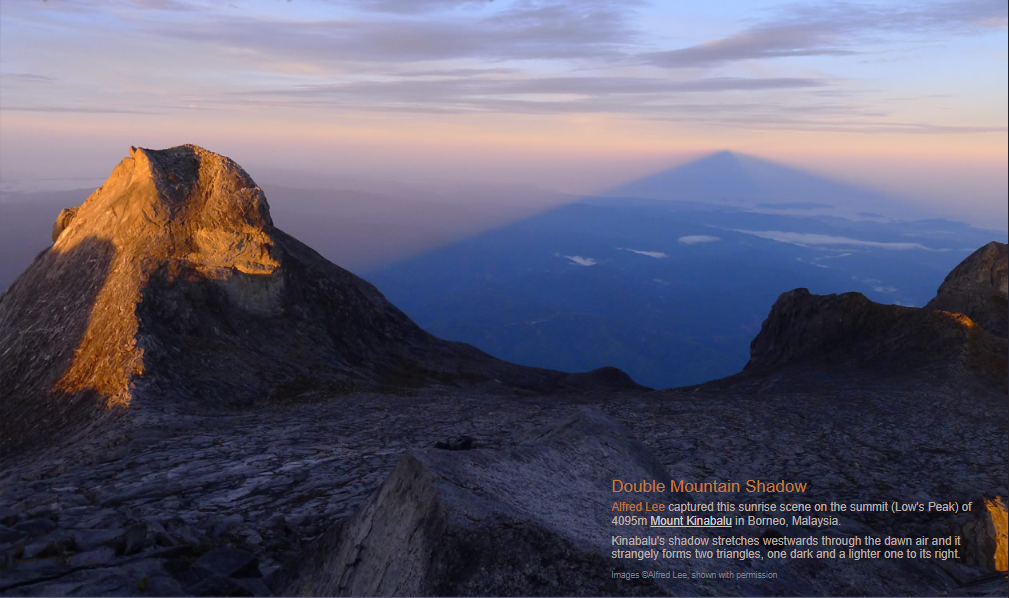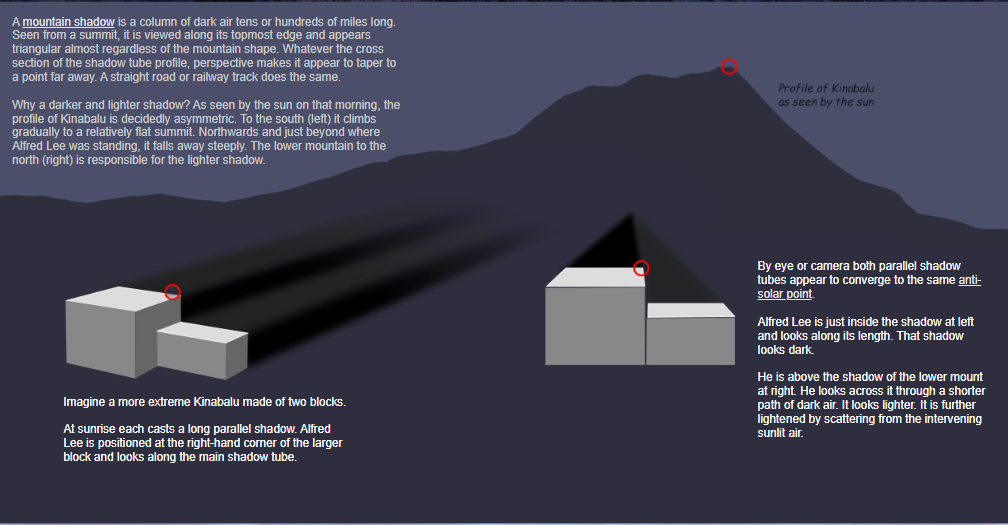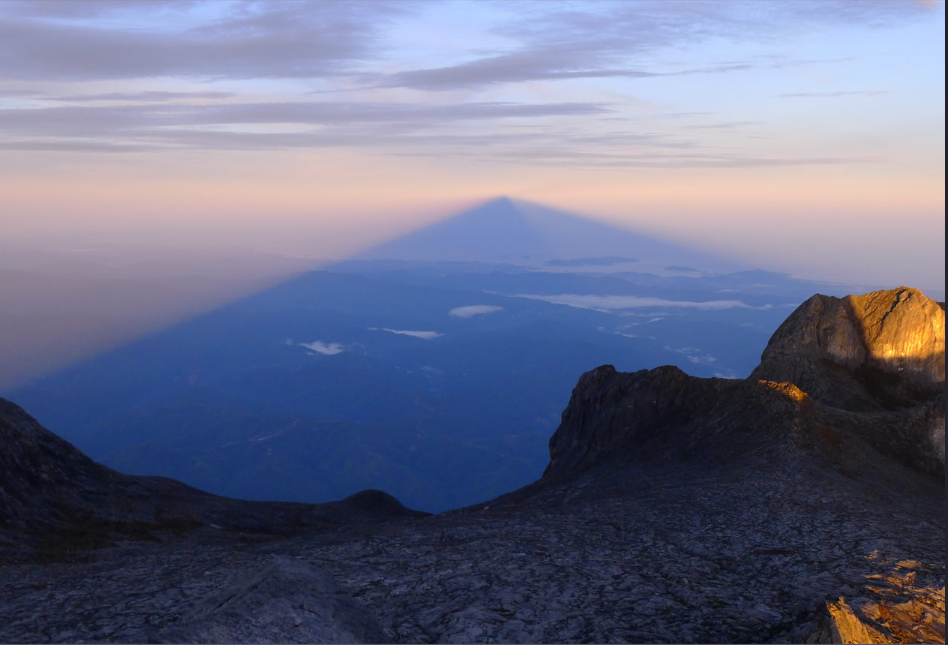Mount Kinabalu double shadow - OPOD
Mount Kinabalu Double Shadow - Exploring the Phenomenon
Mount Kinabalu, located in Borneo, Malaysia, is not only a majestic peak but also the stage for a fascinating atmospheric optics phenomenon known as the double shadow. Captured by Alfred Lee during a sunrise ascent to the summit, this peculiar occurrence offers a unique spectacle for those fortunate enough to witness it. In this article, we will delve into the details of the Mount Kinabalu double shadow and unravel the science behind its formation.
The Enigmatic Double Shadow
As the sun rises over Mount Kinabalu, its shadow extends westward through the dawn air, presenting an intriguing sight: two triangular shadows, one darker and one lighter. The formation of these shadows can be attributed to the asymmetrical profile of the mountain itself. To the south, the mountain gradually ascends to a relatively flat summit, while to the north, it steeply descends. This disparity in topography results in the dual shadows.
Understanding Mountain Shadows
To comprehend the nature of mountain shadows, it is essential to visualize them as elongated columns of dark air that can span tens or even hundreds of miles. When viewed from a summit, such as Low's Peak on Mount Kinabalu, these shadows appear triangular due to perspective, irrespective of the mountain's shape. This tapering effect occurs because the topmost edge of the shadow is what is visible from the observer's vantage point.
A Hypothetical Scenario
To illustrate how the double shadow phenomenon occurs, let us consider a hypothetical scenario. Imagine Mount Kinabalu as two distinct blocks. At sunrise, each block casts its own parallel shadow. If we position ourselves at the right-hand corner of the larger block and look along the main shadow tube, both parallel shadow tubes would seemingly converge at the same anti-solar point.
The Darker and Lighter Shadows
When observing the double shadow of Mount Kinabalu, one may wonder why there is a contrast between the darker and lighter shadows. The answer lies in the varying lengths of the paths the sunlight must travel through the atmosphere to reach the observer's eyes. The shadow of the lower mountain to the north appears lighter because it is viewed across a shorter path of dark air. Additionally, scattering from the sunlit air in between further contributes to the lightening effect.
An Interplay of Light and Perspective
The Mount Kinabalu double shadow serves as a captivating example of how light and perspective can interact to create mesmerizing optical phenomena. The convergence of the parallel shadow tubes, coupled with the asymmetrical profile of the mountain, results in the intriguing contrast between the darker and lighter shadows. This interplay of light and perspective adds an extra layer of beauty to an already stunning natural landscape.
Further Exploration
The Mount Kinabalu double shadow is just one of many atmospheric optics phenomena that grace our skies. Exploring these phenomena can deepen our understanding of light, perspective, and the complexities of our atmosphere. If you ever find yourself near Mount Kinabalu at sunrise, be sure to keep an eye out for this captivating display. It is a reminder of the wonders that nature has to offer and a testament to the fascinating world of atmospheric optics.
Conclusion
The Mount Kinabalu double shadow phenomenon showcases the beauty and intricacies of atmospheric optics. The contrasting dark and light shadows that stretch across the dawn air capture the imagination and provide a visual feast for those lucky enough to witness it. By understanding the interplay of light, perspective, and topography, we can appreciate the mesmerizing phenomena that occur in our natural world. So next time you venture into the great outdoors, keep your eyes open for these captivating displays that remind us of the wonders that surround us.

Double Mountain Shadow?
Alfred Lee captured this sunrise scene on the summit (Low's Peak) of 4095m Mount Kinabalu in Borneo, Malaysia.
Kinabalu's shadow stretches westwards through the dawn air and it strangely forms two triangles, one dark and a lighter one to its right.
Images ©Alfred Lee, shown with permission

A mountain shadow is a column of dark air tens or hundreds of miles long. Seen from a summit, it is viewed along its topmost edge and appears triangular almost regardless of the mountain shape. Whatever the cross section of the shadow tube profile, perspective makes it appear to taper to a point far away. A straight road or railway track does the same.
Why a darker and lighter shadow? As seen by the sun on that morning, the profile of Kinabalu is decidedly asymmetric. To the south (left) it climbs gradually to a relatively flat summit. Northwards and just beyond where Alfred Lee was standing, it falls away steeply. The lower mountain to the north (right) is responsible for the lighter shadow.
Imagine a more extreme Kinabalu made of two blocks.
At sunrise each casts a long parallel shadow. Alfred Lee is positioned at the right-hand corner of the larger block and looks along the main shadow tube.
By eye or camera both parallel shadow tubes appear to converge to the same anti-solar point.
Alfred Lee is just inside the shadow at left and looks along its length. That shadow looks dark.
He is above the shadow of the lower mount at right. He looks across it through a shorter path of dark air. It looks lighter. It is further lightened by scattering from the intervening sunlit air.

Note: this article has been automatically converted from the old site and may not appear as intended. You can find the original article here.
Reference Atmospheric Optics
If you use any of the definitions, information, or data presented on Atmospheric Optics, please copy the link or reference below to properly credit us as the reference source. Thank you!
-
<a href="https://atoptics.co.uk/blog/mount-kinabalu-double-shadow-opod/">Mount Kinabalu double shadow - OPOD</a>
-
"Mount Kinabalu double shadow - OPOD". Atmospheric Optics. Accessed on April 19, 2024. https://atoptics.co.uk/blog/mount-kinabalu-double-shadow-opod/.
-
"Mount Kinabalu double shadow - OPOD". Atmospheric Optics, https://atoptics.co.uk/blog/mount-kinabalu-double-shadow-opod/. Accessed 19 April, 2024
-
Mount Kinabalu double shadow - OPOD. Atmospheric Optics. Retrieved from https://atoptics.co.uk/blog/mount-kinabalu-double-shadow-opod/.